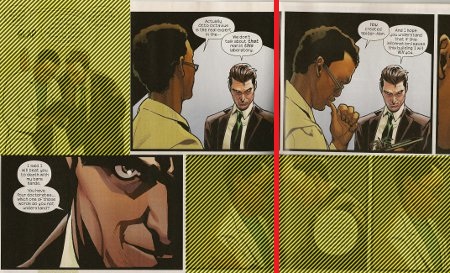I will be reviewing the new Ultimate Spider-Man #1 later on today, but before I do, I’d like to address something that has nothing to do with the quality of the story or art in the new Ultimate Spider-Man, but is instead a humble entreaty to writer Brian Michael Bendis:
For the unholy love of jabbering FUCK, would you PLEASE stop writing two-page paneled story spreads?
If you’ve read pretty much any Bendis book ever in the past ten years, you know what I’m talking about: other than widescreen splash pages, most comic stories unfold one page at a time. You look at the left-hand page, read to the right-hand edge of that page, then down. When you reach the bottom, you then jump to the top of the right hand page, repeat, then turn page. It’s the common language of reading comic books. Hell, it’s the common language of reading ANYTHING published in the ENTIRE WESTERN WORLD, from Dick and Jane to Jane and Dick: An Erotic Adventure.
Bendis, however likes to write spreads that start at the top left, then cross the page binding to the right-hand page, meaning you have to discard years and years of understanding of how the comic page tells a story in order to follow it. Which is acceptable when there is some kind of strong, visual cue that that’s how the page is laid out, like a big panel that crosses the binding with action clearly crossing the fold. Even then, it’s jarring, but you can figure it out and force yourself to adapt to what is NOT conventional comics storytelling.
On pages 4 and 5 of Ultimate Spider-Man #1, however, the last panel in the first row BARELY crosses the fold. You need to REALLY be looking for it to see it. On top of that, here’s how the dialog goes when you read the story on the top row, from page 4 across to page 5, the way Bendis intends, across the fold:
PANEL 2:
DR. MARCUS: Actually, Otto Octavius is the real expert in the —
NORMAN OSBORN: We don’t talk about THAT man in THIS laboratory.
PANEL 3, NEXT PAGE:
DR. MARCUS: YOU created Spider-Man.
And here’s how it reads if you miss the 16th of an inch of panel 2 that crosses the fold, and you skip down to the next row on page 1, as you would in EVERY OTHER NON-BENDIS COMIC IN THE WORLD:
PANEL 2:
NORMAN OSBORN: We don’t talk about THAT man in THIS laboratory.
PANEL 5, SAME PAGE:
NORMAN OSBORN: I said I will beat you to death with my bare hands.
Oh, fuck it – just look at it (The red line is the binding fold):
You see the problem? Let’s say you bought this book last night, and let’s further say that your local comic store is two doors down from a bar that serves excellent rye whiskey cocktails. So, as most people would, you pop into the bar and spend four hours drinking dinner, and then adjourn home, somehow find the wherewithall to scissor open the polybag containing the book without utterly destroying it, and then hit these pages… and STOP DEAD.
“Wha?” you might think, “When did Osborn say he was gonna beat the guy to death? It sort of makes sense that he would say that because he’s kinda pissed that Marcus mentioned Doc Ock, but when did he threaten… Did I black out somehow between pages 1 and 3? Okay, calm down. You don’t smell burning toast, so this probably isn’t a stroke. Let’s flip back and… nope, nothing about a beating on page 3… or 2… maybe I should call 911 – wait! This is BENDIS! That means… yup; that panel border is a purely theoretical number of picometers across the page fold! This is a BENDIS SPREAD! So I need to cross the – got it. Okay, back to the book… wait, who’s this geek again?”
It’s the lens flare of the comic book work, Bendis. It drags me right out of the story. And while I don’t like it, I can understand wanting to do it for a big action sequence where having two pages to tell one page of story means that the artist gets extra real estate to show off a sequence of, say, Spider-Man fighting Doctor Octopus. This, however, is a sequence of two science nerds talking about Spider-Man and Doc Ock.
Look Bendis – I get that you’re a “Marvel Architect” and that means that you can chuck any weird directions into a script that you want, and the artist’ll follow them and Axel Alonso’ll vet them. But your writing is generally too Goddamned good for you to buck storytelling convention and make it difficult and confusion for me to read it.
It’s unnecessary. Stop it. Please.

 Podcast RSS Feed
Podcast RSS Feed iTunes
iTunes Google Play
Google Play Stitcher
Stitcher TuneIn Radio
TuneIn Radio Android
Android Miro Media Player
Miro Media Player Comics Podcast Network
Comics Podcast Network